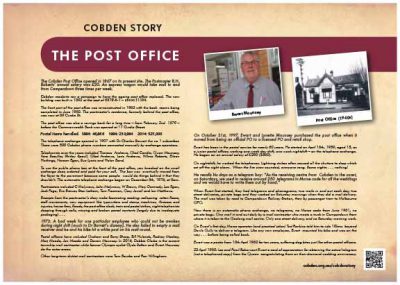Post Office

![]() This plaque is located at 21 Curdie St.
This plaque is located at 21 Curdie St.
The Cobden Post Office opened in 1867 on its present site. The Postmaster R.H. Roberts’ annual salary was £20. An express wagon would take mail to and from Camperdown three times per week.
Cobden residents ran a campaign to have the ageing post office replaced. The new building was built in 1892 at the cost of £678-6-1 – about $1360.
The front part of the post office was re-constructed in 1963 with the back rooms being completed in June 1980. The postmaster’s residence, formerly behind the post office, was now at 89 Curdie St.
The post office was also a savings bank for a long time – from February 2nd 1879 – before the Commonwealth Bank was opened at 17 Curdie Street.
Postal items handled. 1884: 46,866 1984: 230,984 2014: 525,000
The telephone exchange opened in 1907 with Dr Charles Stewart the no 1 subscriber. There were 500 Cobden phone numbers connected manually by exchange operators.
Telephonists over the years included Theresa Andrews, Glad Condie, Gwen Mounsey, Vera Scouller, Shirley Spaull, Glad Andrews, Loris Andrews, Wilma Roberts, Eileen Horkings, Noreen Egan, Sue Lyons and Helen Bond.
To use the public phone box at the front of the post office, you knocked on the small exchange door, ordered and paid for your call. The box was eventually moved from the foyer to the pavement because some people would do things behind it that they shouldn’t. The automatic telephone exchange began on December 8th, 1976, at 8am.
Postmasters included C Molyneux, John Molyneux, W Brown, Mary Dermody, Leo Egan, Jack Page, Eric Brewer, Stan Latham, Tom Freeman,
Gary Jewell and Ian Matthews.
Excerpts from the postmaster’s diary make fascinating reading: collapsing rotten floors, staff movements, new equipment like typewriters and stamp machines, illnesses and injuries, house fires, floods, the post office clock, train and postal strikes, night telephonists sleeping through calls, missing and broken parcel contents (largely due to inadequate packaging) . . .
1973: A bad week for one particular employee who could not be awoken during night shift (much to Dr Barrett’s dismay). He also
failed to empty a mail receiver and he and his bike hit a white post on his mail round.
Postal officers have included Graham and Barry Sharp, Bill Hulands, Rodney Mackay, Marj Meade, Jen Meade and Darren Mounsey. In 2016, Debbie Clarke is the current township mail contractor while former Olympic cyclist Clyde Sefton and Ewart Mounsey do the outer areas.
Other long-term district mail contractors were Tom Bourke and Ron Willingham.
On October 31st, 1997, Ewart and Lynette Mounsey purchased the post office when it moved from being an official PO to a licensed PO and retail shop.
Ewart has been in the postal service for nearly 60 years. He started on April 16th, 1959, aged 15, as a junior postal officer, working one week day shift, one week nightshift – on the telephone exchange. He began on an annual salary of £290 ($580).
On nightshift, he worked the telephones. Lightning strikes often caused all the shutters to drop which set off the night alarm. When the fire siren sounded, everyone rang. Some nights . . . nothing!
He recalls his days as a telegram boy: “As the receiving centre from Cobden to the coast, on Saturdays, we used to receive around 250 telegrams in Morse code for all the weddings and we would have to write them out by hand.”
When Ewart first started, they had telegrams and phonograms, two mails in and out each day, two street deliveries, private bags and they worked on Saturday mornings when they did a mail delivery. The mail was taken by road to Camperdown Railway Station, then by passenger train to
Melbourne GPO.
Now there is an automatic phone exchange, no telegrams, no Morse code from June 1961, no private bags. One mail in and out daily by a mail contractor who meets a truck in Camperdown from where it is taken to the Geelong mail centre. Only one street delivery, and no Saturday morning work.
On Ewart’s first day, Morse operator (and practical joker) Ted Rankins told him to ride 10kms beyond Devils Gully to deliver a telegram. Like any new employee, Ewart mounted his bike and was on the way . . . before being called back.
Ewart was a postie from 18th April 1962 for ten years, suffering dog bites just like other postal officers.
23 April 1980: Les and Pearl Baker sent Ewart a card of appreciation for obtaining the actual telegram (not a telephoned copy) from the Queen congratulating them on their diamond wedding anniversary.
